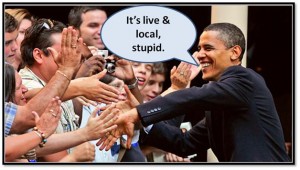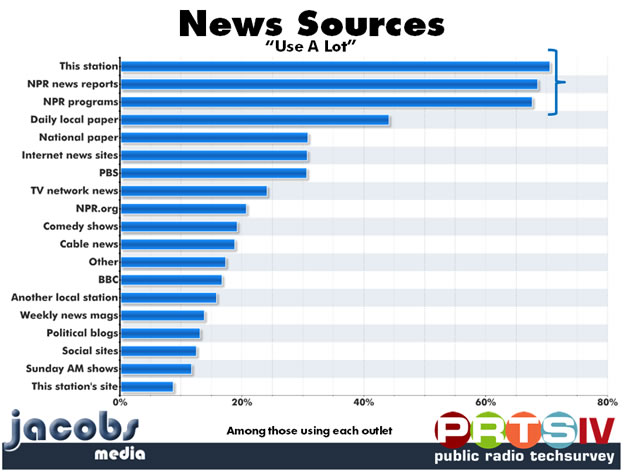I have a feeling that if President Obama were in radio, he wouldn’t be a big fan of nationally syndicated programming and voicetracking.
How do I know this?
 Well, if you look at what his campaign is up to this summer, you can see that despite having the incumbent’s advantage in holding photo ops from the Rose Garden and the Oval Office, more and more, he is focusing on having a presence in local markets.
Well, if you look at what his campaign is up to this summer, you can see that despite having the incumbent’s advantage in holding photo ops from the Rose Garden and the Oval Office, more and more, he is focusing on having a presence in local markets.
I am always amazed by radio wags who deride the “live & local” philosophy, often using the success of national stars like Jay Leno or shows like American Idol as examples that entertainment is entertainment, no matter where it originates.
While it’s true we enjoy watching the Olympics or 60 Minutes – widely shared global programming phenomena that everyone will be talking about, the funding for your local art museum, potholes on your local freeways, and the impact the drought is having on area farmers are all issues that hold a special relevance to your listeners.
A new piece by Michael Calderone in the Huffington Post last week confirmed the Obama 2012 campaign’s commitment to hitting the streets – and not just for spaghetti dinners and union hall meetings.
President Obama is engaged in a local media blitz in those swing states, where he can speak directly to local constituencies about what matters to them. In 2012, Calderone counts 58 local media interviews this year, and that number is growing.
Yes, jobs, health care, and other national issues mean a great deal to most Americans. But when you’re living in Manchester, Milwaukee, Des Moines, or Delray Beach, what matters to you are hometown, grassroots issues.
As Calderone points out, there are political advantages to keeping it live and local:
- Local anchors aren’t as likely to ask those really tough questions
- Interviews are easier to manage than press conferences
- You can talk about what matters to the locals
 But what this strategy is really about is being where the voters are – something that radio is slowly but surely figuring out. In the article, Obama’s press secretary Ben LaBolt (pictured) puts it this way:
But what this strategy is really about is being where the voters are – something that radio is slowly but surely figuring out. In the article, Obama’s press secretary Ben LaBolt (pictured) puts it this way:
“It’s no secret that Americans are getting their information from a more diffuse body of media sources, and we always work to ensure that we’re reaching them where they’re getting their information. Some of those means are traditional – like national and regional drive time radio, or interviews with networks and their affiliates across the country… but it’s also important for us to engage digital and social media platforms, from online chats to blogger conferences, and platforms accessed by growing constituencies to reach as many Americans as possible.”
Know where the people are.
Be where the people are.
Mix traditional media and new platforms.
Grow reach by connecting with digital communities.
Our recently wrapped up tech survey for public radio – PRTS4 – put the exclamation point on this strategy.
A key question this year spoke to knowing where people are getting their news and information. With this kind of data, local station brands can better reach their listeners – and their members – with a better handle on the different media, platforms, and gadgets they’re using to stay informed.
Whether it’s beefing up those proprietary channels or using other outlets to reach your current listeners – or potential cumers – the knowledge of who’s using what is the most powerful data you can gather.
It used to be that radio marketers would have killed to be able to reach the competition’s audience. Today, you can connect with current fans as well as new ones without having to use telemarketing and other hackneyed marketing tools of the past. You can determine where the audience hangs out when they’re not spending time with you.
Whether you support President Obama or want to see him swept out of office, his campaign’s media strategies are always worth studying.
This year, Main Street is at the heart of it. But so is moving where the audience has moved.
It’s live and local.
- Media In 2025: Believe It Or Not! - January 15, 2025
- Every Company Is A Tech Company - January 14, 2025
- The Changing Face Of Social Media (OR WTZ?!) - January 13, 2025





Leave a Reply